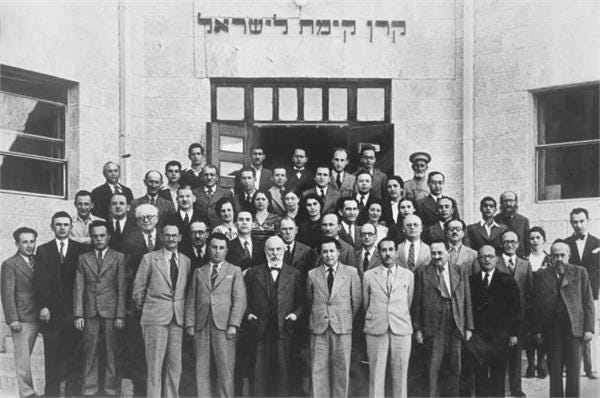Building up the Jewish state? The refugees can do it
American Jews and the Holocaust: Part 5
This is part 5 of an ongoing series. Read part 1, part 2, part 3, and part 4.
How did American Jews deal with the Holocaust in the years after the war? More poignantly, how did they deal with the survivors they encountered? In We Remember with Reverence and Love, Hasia R. Diner challenges the commonly accepted notion that for years and even decades after the Holocaust, American Jews were silent and refused to discuss it or deal with it publicly. She gives various examples of how American Jews indeed honored the memory of those murdered in the Shoah. One was a Passover Haggadah created in 1952: “The first paragraph of the Seder Ritual of Remembrance intoned that ‘we,’ those assembled who had been directed to stand, ‘remember with reverence and love the six million of our people of the European exile,’ who had been destroyed by ‘a tyrant more wicked than the Pharaoh who enslaved our fathers in Egypt.’”

Another was a public speech by Oscar Handlin, a Harvard professor, who reminded his audience, “Nor can we, in the midst of our joy and well-being, blot out the memory of the tragic decade that has just closed. Honesty demands that as we celebrate we have in our minds also the stark facts of our present situation. Jews have not recovered from the shock of the six million victims of the European catastrophe.”
Diner’s argument seems almost a direct response to Haskel Lookstein’s judgment that American Jews did not feel enough anguish—were not paralyzed by it—in the wake of the Holocaust. It’s true: the American Jewish community was not silent about the Holocaust during or after the war. As Diner amply demonstrates in her book, they made memorials and remembrances that were public and private, oral and written. There’s an acute difference, however, between the way that a community deals with an idea in the abstract and the way that it deals with people. The issue here is a human one: how people responded to people; how American Jews treated, welcomed, or rejected those European survivors who were physical, visual reminders of the tragedy and destruction that had consumed the Jewish communities of Europe.
So how did American Jews—as individuals, as communities, and as organizations—receive and respond to the Jewish survivors who immigrated from Europe after the war?
First it’s important to consider the American postwar environment. After winning the war, Americans simply wanted to get on with their lives as normally as possible, and they didn’t want to deal with its remnants. Also, attitudes toward Jews and other foreigners hadn’t significantly changed. The American population was not exactly ready to welcome the Jewish refugees, often classified as Displaced Persons, with open arms. In her comprehensive study of the Jewish survivor experience in the United States after the war, Case Closed: Holocaust Survivors in Postwar America, Beth B. Cohen confirms that “America, too, had not only legislation to restrict entry into the country but also a native population that wanted to see the displaced persons go elsewhere.” Cohen cites a Gallup poll from January of 1946 which “indicated, despite or perhaps because of anti-Semitism, that 76 percent of non-Jewish voters polled were sympathetic to permitting Jews to settle in Palestine.” So on the one hand, Americans largely supported the establishment of a Jewish state; on the other, it is unclear whether they supported that because of a genuine belief in its necessity or because of an antisemitic desire to keep additional Jews out of the United States.
Photo: Jewish National Fund photo archive
The Jewish refugees themselves often preferred to go to Israel over America, but they went wherever they were given the opportunity to go. America, however, was not keen to welcome them. For their part, American Jews did not particularly want the refugees to settle in the States, but not for the same reasons as other Americans who were xenophobic, antisemitic, or simply did not want to deal with the survivors. Rather, the “destruction of European Jewry had made Zionists out of most American Jews and convinced them of the need for a national homeland. It was there, not in the United States, that the majority wanted the refugees to settle.”
The terrible war that had just ended and the near-total annihilation of European Jewry had persuaded American Jews that in any foreign land, Jews could never be totally safe from antisemitism and persecution, and they would never be truly safe as a people until they had a secure homeland in the land of Israel. For the majority of these American Jews, however, they believed this on behalf of their near-destroyed European brethren, not themselves. They believed in the Zionist dream enough to want to see the European refugees settle in the land and help rebuild the Jewish state; it was for the refugees to build, however, while American Jews could rest safely at home. Thus, even from the earliest postwar years, American Jews held mixed feelings toward the European Jewish refugees who settled in the United States rather than the land of Israel.
This is part 5 of a series. Stay tuned for the next installment.


